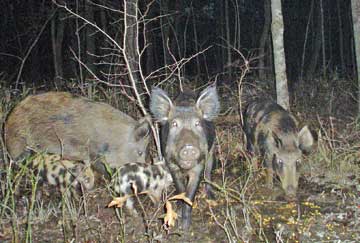Feral hogs have the opportunity to be an ecological disaster. Feral hogs and introduced wild boar represent many unknown ecological impacts to state and federal wildlife biologists, wildlife land managers, landowners, and even hunters. The danger or impacts of feral hogs pose to our native plant and animal communities are not fully understood. In some areas, feral hogs have been credited with the decline of bobwhite quail numbers, but at the same time there are other places where quail numbers are high despite a high feral hog population. Without additional research, the real impact of wild hogs is unknown.
Feral hogs are believed to have significant impact on all ground-nesting birds, including wild turkey nests. Wild hogs can impact various plant species and change entire ecological systems. However, the actual effect feral hogs have on our environment remains unknown without additional scientific studies. More research and practical knowledge are needed to give us a better understanding of the feral hog and its influence on game and non-game species, as well as the environment and its ecosystems.

Researchers do know that feral hogs can carry and transmit some diseases and parasites to livestock and humans. Feral hogs can have a significant negative impact on some livestock operations through depredation and damage to facilities and fences. Farmers and ranchers also share a significant portion of the damage caused by the rooting of fields, depredation of crops, and the destruction of fences. Feral hogs are a challenging wildlife species to pursue by hunters, yet they also compete with white-tailed deer for native food and habitat.
As you have read, there are many pro’s and con’s regarding the status of feral hogs in North America. The impact feral hogs will have on the long-term health of our native environments has yet to been seen, but we can only hope to minimize those impacts and control feral hog numbers.